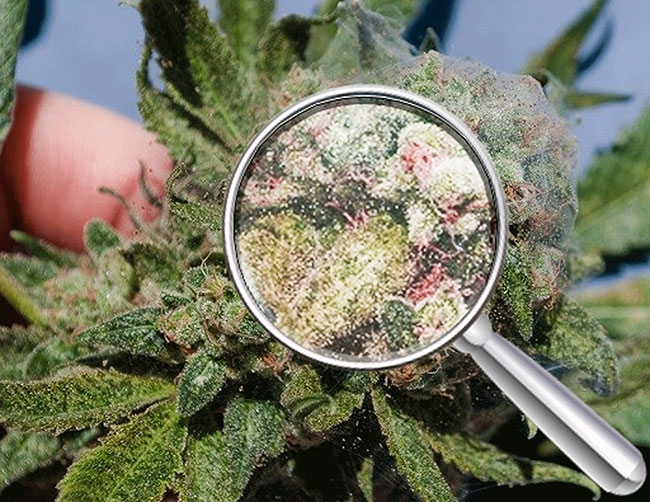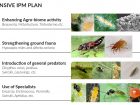
Features
Biocontrols
Inputs
Four P’s for Cannabis IPM
It’s a challenging crop requiring considerable attention to Prevention, Pinching, Pruning…and of course Patience.
November 23, 2017 By Dr. Abida Nasreen
 Two spotted spider mite on cannabis plant.
Two spotted spider mite on cannabis plant. December 2017 – Cannabis sativa has been used medically, recreationally and spiritually throughout the world for about five millennia now. In recent times there has been an increasing trend of the public being more accepting towards the use of cannabis as a medical treatment option for various illnesses.
Cannabis contains over 60 unique cannabinoids and 460 active chemicals. The main active ingredient in cannabis is tetrahydrocannabinol (THC), which is responsible for its users to feel the therapeutic and psychoactive effects. A vast number of comprehensive studies are ongoing to learn about the effects of cannabis from a medicinal point of view and to figure out various cost-effective, as well as productive, ways to grow the crop.
Medicinal cannabis can help with severe nausea and vomiting associated with cancer chemotherapy or other causes, weight loss associated with debilitating illnesses including HIV and cancer, neurological diseases, pain syndromes and glaucoma. One of its most promising effects is that it is used to treat muscle spasms in patients with multiple sclerosis and there are countless more beneficial effects of the cannabis.
Growing cannabis commercially is very tricky because it is quite vulnerable to various pests, diseases and growing conditions. Paying attention to details at each growth stage of the plant is very crucial when growing in a greenhouse or enclosed structure. The indoor cultivation enables growers to create a suitable environment for growing a healthy crop free of pests and diseases. High humidity can lead to an epidemic outbreak of bud rot. It is always advised to use preventive measures to avoid the problems of pests and diseases rather to take drastic curative measures later to save the crop when there is an epidemic outbreak.
A well-crafted IPM strategy is very helpful for a cannabis grower to improve pod quality and minimize the losses. The benefits of using the right IPM program has been established by scientific research – it saves money, is easier on the environment, is an alternative to the use of toxic chemicals, and it balances the crop ecosystem.
An effective integrated pest management plan consists of four P’s.
Prevention: This starts at the very beginning of the crop. A clean start is a very important component that includes the cleaning up of all crop and weed residues from the growing area, completely disinfecting with selective and non-persistent disinfectants, and planting with healthy clones. It is very important to inspect clones for any sign or presence of pests and diseases.
Proper fertigation and climate conditions are essential to grow the crop profitably. Better airflow, good light and optimum humidity and temperature help to grow vigourous plants, very much reducing losses due to pests and diseases. Humidity levels between 50 to 80 per cent depending on the cultivars are considered suitable. Very low humidity in enclosed containers is not good for the plant or workers’ health. The environment becomes more crucial during the vegetative growth stages.
With biotic components of agricultural biodiversity such as agrobiomes, general predators in soil and on the crop work very well to combat plant diseases and pests. Introduction and enhancing the growth of the benficial microbes both in the growing media and plant foliage can control many of the diseases infecting the root system and the aerial parts of the cannabis plant such as the stem, leaves and buds. Spraying of the beneficial microbes mixed with some microbial enhancing nutrients at the start of crop is a good technique. The presence of generalist predators on the ground and in the crop is a key to success in the war against the important crop pests such as spider mites, fungus gnats, thrips, aphids, loopers, etc.
The generalist predators includes Atheta and Hypoaspis in growing media, and Swirskii, Dicyphus, lacewings and Podisus in crop foliage. The best way to introduce generalist predators active on plant foliage is by using the sachet system for predatory mites and the banker plant system to support Dicyphus and Orius. Beauveria, Matarhizium, B. Subtilis and Trichoderma are important beneficial microbes commercially available. These fungi are very effective when sprayed tank-mixed with MycoLiv (a nutrient supplement). Specialist predators and parasitoids are effective only when the pest has been detected in the crop through a regular pest scouting and monitoring process.
Pinching: This involves cutting off the main shoot at the top, thus stimulating the growth of more shoots and branches. Over time, it will turn the plant’s overall shape into a downward-facing cone, which will help the plant maximize the use of light that it receives. This is more important when the plants are raised in closed containers using artificial light that is limited (and expensive) compared to natural sunlight. Keep the plants fully on vegetative nutrients through the first and second week of flowering followed by steering the plants to a generative phase by manipulating feed and the environment. The open, well-ventilated, generative and hardy plants are very less prone to plant diseases.
Pruning: The previous precautionary measures are not enough to stop the occurrence of diseases and pests from entering the greenhouses or other closed structures. Pruning is an extremely useful tool to get the healthiest plants with the most THC at the end of harvest. Removal of the dead leaves could save plant resources being wasted on dying limbs. These resources are then used on more important things, such as the still-healthy leaves or by growing new leaves. With more efficient use of resources, the end result will be a larger, healthier plant.
When done right, pruning maintains uniform temperature to prevent dew on leaves, allows for uniform spacing of plants for proper light penetration, and is important to prevent diseases.
Patience: Like all other plants, cannabis is a good food for different kinds of insects and disease pests. A grower will encounter a variety of pests such as caterpillars, mealybugs, aphids, thrips, fungus gnats, whiteflies and the dreaded spider mites. A good grower must have the ability to deal with all these critters carefully and patiently.
As mentioned earlier, the best bet is to be preventive rather than reactive. In spite of all efforts there might be a pest flareup, so you must rely on biological pest control methods with the consultation of biocontrol experts. Release good quality beneficial insects and mites for the best outcome. Such pest control methods take time to be effective. So patience is key to get positive results from biocontrol methods.
DISCLAIMER: The information presented here is for research purposes only, and to showcase the importance of IPM strategies. Products mentioned in this article may not be registered for use in Canada. Please read and follow label directions before using any crop protection products.
Dr. Abida Nasreen is director of R&D with GrowLiv Ltd., www.growliv.com.
Print this page

